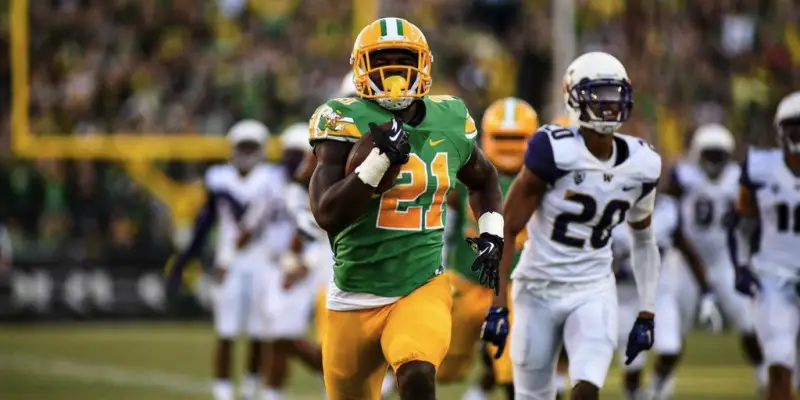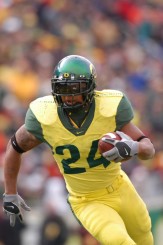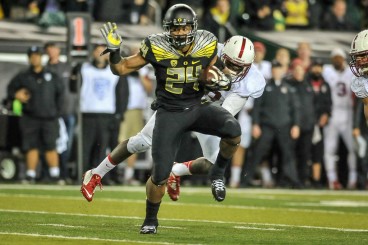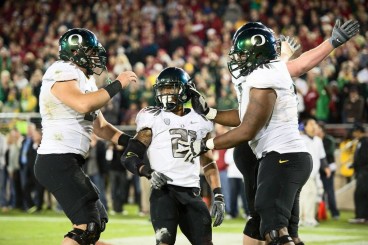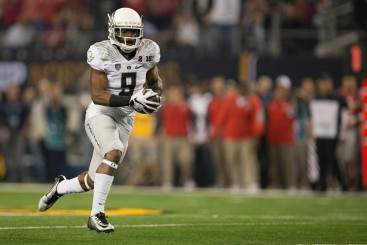While Heisman Trophy winner Marcus Mariota will surely be missed in 2015, Oregon’s offensive backfield remains loaded with firepower. Royce Freeman, Byron Marshall, and Thomas Tyner have the talent to be the best batch of running backs in the country in 2015 and the greatest group in Oregon’s long line of stars at the position.
Mariota temporarily altered the team’s image throughout his career, giving the offense a reputation as a dominant passing force. However, the truth is that for this century at least, Oregon has been more prone toward leaning heavily on the ground game. In 2009 for example, quarterback Jeremiah Masoli averaged only 180 passing yards per game, putting the Ducks at 98th nationally in that category. LaMichael James rushed for over 1,500 yards and Oregon won the conference.
Since Chip Kelly took over as head coach in 2009, the Ducks have finished in the Top 10 in scoring each year, but only finished in the Top 20 in passing once (2014). Conversely, they have finished in the Top 10 in rushing yards per game in five of the past six seasons, and the success of the ground game started long before Kelly’s arrival. Reuben Droughns, Maurice Morris, Onterrio Smith, and Terrence Whitehead are great examples of Oregon’s history of consistent rushing prowess.
In fact, since the start of the 1999 season, Oregon has produced eleven 1,000-yard rushers and eight NFL Draft selections at the position, making it college football’s top running back factory in that span. Alabama is the only other comparable school, producing seven different 1,000-yard rushers and six NFL Draft selections over that same timeframe. In other words, Oregon has featured more star power at running back than other other college program over the past 15 years.
Oregon’s play-calling tendencies also reflect its preference for the ground game, especially since Kelly’s arrival. Over the past six seasons, the offense ran the ball on 61.8 percent of its plays, a number brought down a bit during Mariota’s relatively pass-happy career. (Oregon ran on only 58 percent of its plays between 2013 and 2014.)
Even with this immense success in recent history, it appears as though the best is yet to come. With highly-touted prospects Taj Griffin and Malik Lovette joining Marshall, Freeman and Tyner, Oregon’s rushing attack looks as good as it ever has.
But, as talented as this group is heading into 2015, it is versatility that makes it so special.
The height of Oregon’s rushing attack was arguably in 2011, when LaMichael James, Kenjon Barner, and De’Anthony Thomas were splitting touches in Eugene. James and Barner now sit atop the school’s all-time rushing leaderboard in that order, and Thomas was a threat to score every time he touched the ball.
That year, Oregon led the nation in rushing efficiency, averaging 6.66 yards per carry. The trio also averaged 6.76 yards per carry on first downs, regularly providing the Ducks with easy short-yardage situations on later downs. They also stood out for their big-play ability, leading the country in runs of 30 or more yards with 22. Thomas even led all running backs with 16 yards per touch. In terms of ability, these three were plenty versatile in their own right, each capable of running, receiving, and returning.
However, college football players are becoming bigger, faster and stronger every day, and the fact is that none of 2011’s stars eclipsed 195 pounds. As a result, though Oregon had three exceptional players, it really only had one model. That limited bulk became an issue against some of the bigger defensive fronts that they faced.
On the other hand, Marshall, Freeman and Tyner each weigh at least 200 pounds. James was certainly an underrated bruiser between the tackles, but he was not the same kind of physically overpowering runner that Freeman, at 230 pounds, is on the inside.
It is important to note that this added size comes at the cost of almost no speed or explosiveness. In 2014, Oregon still finished near the top of the national standings in both long rushing plays, breaking 34 runs of 20 yards or more, and first down rushing with 5.97 yards per carry.
Perhaps more significant than the explosiveness, though, is the balance, because Oregon now has three models at running back. Marshall already has 1,000-yard seasons as both a rusher (2013) and receiver (2014) under his belt, and his ability to line up out wide makes him one of the most flexible offensive players in the country. Freeman is the big man capable of grinding out the tough yards, and Tyner rounds out the group with a rare blend of speed, size and toughness that gave him five stars as a recruit coming out of high school.
The group’s experience is an added bonus. Thomas was a true freshman back in 2011, and James and Barner had a combined 677 career carries heading into the season. Marshall, Freeman and Tyner already have a combined 787 career carries, a number that does not even include Marshall’s 74 receptions from a year ago. Because all of these three backs now have recorded at least a year as a star in the Oregon offense, they should be ready to fill leadership roles in 2015.
The Ducks have had two 1,000-yard rushers in the same season in 2001 (Maurice Morris and Onterrio Smith) and 2008 (Jeremiah Johnson and LeGarrette Blount). Marshall should continue to spend most of his time at receiver which will provide a better opportunity for Freeman and Tyner to become the third duo to accomplish that feat. Despite their remarkable career numbers, even James and Barner were not able to do this in the same year, though they did come close (Barner had 939 in 2011).
Mariota was exceptional during his time at Oregon, but his departure does not spell doom for the offense. Freeman, Tyner and Marshall will mark a return to the run-dominant identity this year with Mariota moving on to the NFL.
The most exciting part for Duck fans is that we have likely not yet even seen the best out of Tyner and Freeman. Tyner has struggled with nagging injuries and missed four games last year, while Freeman will only continue to develop both physically and mentally with more experience. Considering Marshall’s receiving ability, Freeman’s size, and Tyner’s balanced skill set, it will be as challenging as ever to defend the Oregon offense in 2015.
Top Photo By Craig Strobeck
Related Articles:
Oregon Enters Playoffs Better Off Than Last Year
Will The Coaching Carousel Kill Oregon's CFP Chances?
The Playoff Formula Hasn't Changed
Oregon Aims to Bury Dawgs, Punch Playoff Ticket in Rivalry Clash
Huskies Are the New Beavers, Stay In Your Lane Kiffin, and the Civil Apple Cup War
Oregon Football: The X-Factor Vs. Washington
Joey Holland graduated from the University of Oregon in 2013, majoring in History. He played several sports in high school, though football remains his passion. He has yet to miss a single Oregon Ducks home football game during his time in Eugene. Joey has written previously for Bleacher Report and Football Nation.
Joey welcomes your feedback.

